The founder
Born in Fort Worth, Texas in 1904, Mrs. Billie Trimble Chandler lived a life that reflects her personal maxim: "Life begins when you want it to begin and ends when you want it to end." She married Sidney Chandler in 1922 and moved to Corpus Christi, where she raised two sons and two daughters.
After her divorce, Mrs. Chandler decided to embark on a new path in life. In her late forties, she enrolled at the University and earned a master's degree in 1955. She began her teaching career as a schoolteacher and also traveled to various countries, eventually finding a teaching job in Japan.
Mrs. Chandler returned to Corpus Christi in 1971 after teaching abroad for nearly 17 years,mainly in Japan, bringing with her a significant collection of Japanese art. Her collection filled eight flat-bed railroad cars, making it the largest private shipment ever to cross the Pacific at that time. She acquired a warehouse and converted it into a Japanese art museum to share her collection and appreciation for cultures with others, especially children.
Eventually, Mrs. Chandler donated her art collection to a non-profit organization, the Billie Trimble Chandler Art Foundation, so that everyone could partake in the beauty of the art she had spent so many years collecting. It opened in 1974 and is now called the Texas State Museum of Asian Cultures and Education Center at 1809 N. Chaparral St, Corpus Christi.
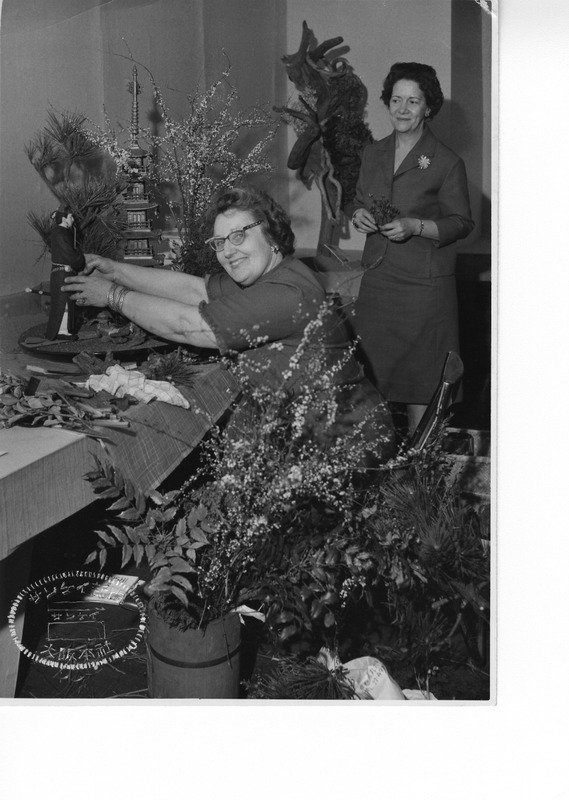
Creating Hakata Ryu Flower Arrangement
She is placing Prince Shotoku figure next to the five-story pagoda with flower arrangement for depicting the scene. He is well known for modernizing the government administration and for promoting Buddhism in Japan in 7 centuries.
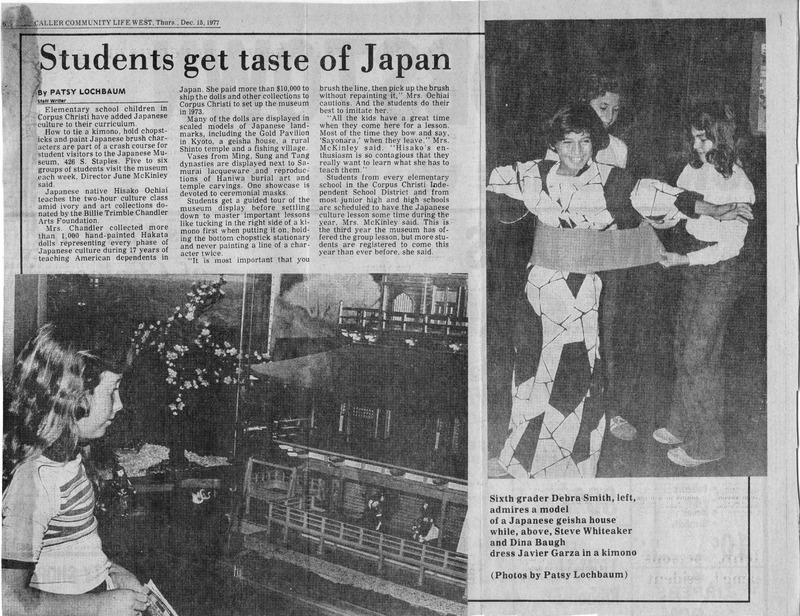
Students get taste of Japan
Elementary School children in corpus Christi have added Japanese culture to their curriculum. They had a great time experiencing various Japanese cultures by using Mrs. Chandler's collections in the museum.
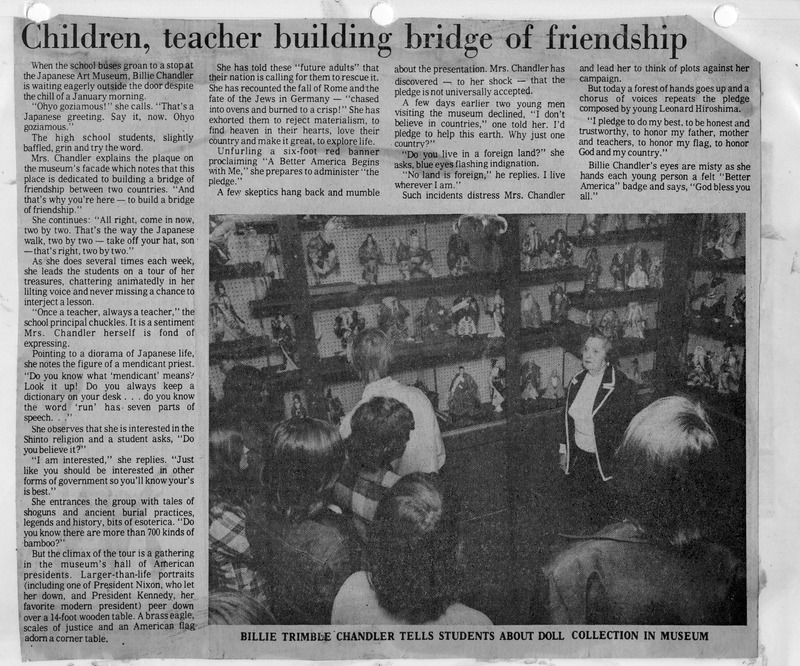
Museum to build a bridge of friendship
Her love for both the children of America and of Japan has prompted her to establish the museum for them. It was fulfilled her desire to bridge the gap between both countries through her collection. “I want to dedicate a museum to the friendship between Japan and America. I want to work for world unity and peace. “ she said.
As a school teacher
After graduating from university, Mrs. Chandler returned to Corpus Christi. She taught speech and social science at Tuloso Midways High School and later served as a Director for the American Junior Red Cross. Then, she taught sixth grade at Flour Bluff Elementary School.
One day, a magazine ad caught her eye, looking for teachers in Okinawa. She decided to take on a new adventure and moved to Japan in 1955. For a year, she taught at an American Dependent School in Okinawa. The following school year, she taught for the Air Force in the Philippines.
For many years after that, she taught at the American Dependent School in Tokyo and Itazuke, near Fukuoka, on the island of Kyushu, in Japan.
Life in Japan
In the 1950s, while teaching in Japan, she fell in love with the Japanese people, art, and culture. This love led her to study, research, and collect many works of art, including Japanese flower arrangements. Her passion for Hakata dolls, in particular, led her to amass a large collection, and eventually open her own museum. She earned teaching certificates from several schools of Japanese flower arrangements and devoted herself to learning more about Japanese culture, including Shinto and Buddhism. She traveled over 7,500 miles across Japan, visiting shrines and temples to gain a deeper understanding of the country's lifestyle and customs. Additionally, she commissioned two artists to depict the richness of Japanese culture.
The uniquely different aspect of Japan lies in the country's simple geographical limitations and the significant population density that is a part of everyday life. This constant crowdedness has influenced Japanese literature, art, architecture, manners, and morals over the centuries. If I had to describe the uniqueness of the Japanese people in one sentence, I would say, "So many people in such a small country" - Mrs. Billie Chandler.
She stayed in Japan at a time when the country was still recovering from the war and experiencing economic growth after the Allied Powers' occupation of Japan (1945–52) following its defeat in World War II.
Mrs. Chandler believed it was important to document in words and pictures some of the attitudes, customs, and traditions before they were altered by modern influences.
Encountered the Yamaga Paper Lantern
" You never know when you open a door, you will find a new world to conquer," she said when she visited a small local shrine called Omiya Jinja in Yamaga City with her friends. While exploring the shrine museum, she was amazed to see miniature replicas of famous Shinto shrines and Buddhist temples of Japan made entirely of paper lanterns. She was speechless and began dreaming of sharing these delicately created architectures with people in America.
Determined to make her dream a reality, she asked the priest if she could buy the lanterns without asking their price. She purchased 13 of them that were available at the time and decided to meet the great architects of the paper lanterns and visit all places of these architectures. She visited Yamaga City and the Lantern Festival repeatedly to learn more about these artworks and architecture while in Japan.
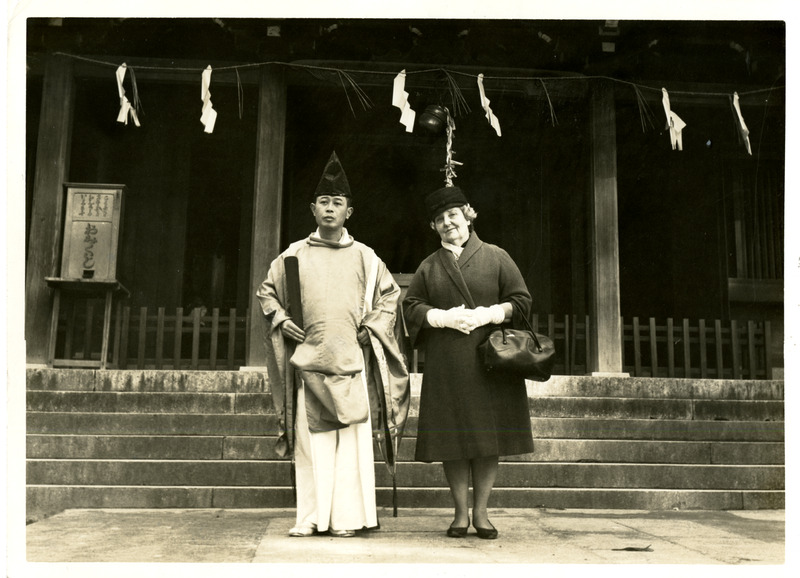
In front of Omiya shrine with Shinto priest
This is the place where she encountered the beautiful paper lantern architecture which is given as an offering to this shrine during the Yamaga lantern festival. These replicas of actual buildings are made to scale at around 1/120 to 1/30 reduction with only paper and glue.
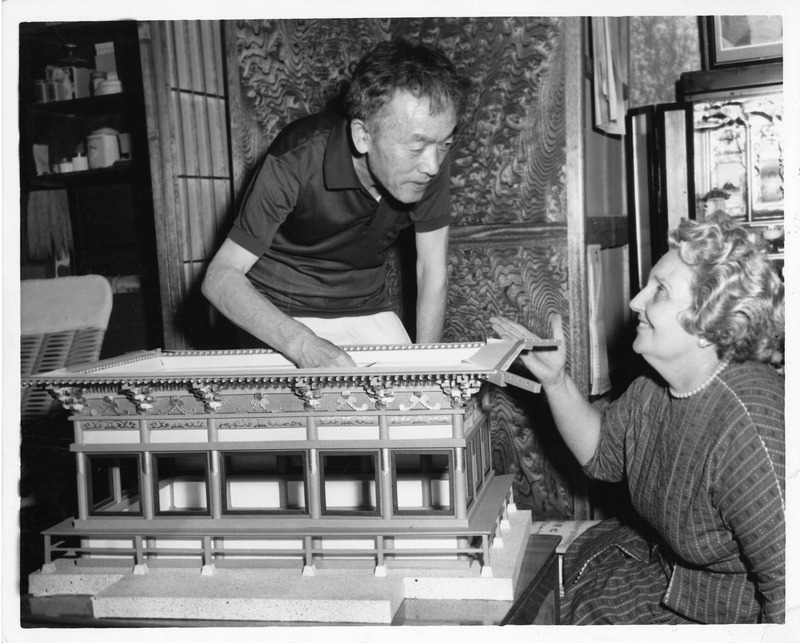
With paper lantern maker, Mr. Higashida
Mrs. Chandler visited the atelier of Mr. Higashida making a paper lantern, a Konpira shrine. She learned the technique and process of making, and the story behind it.
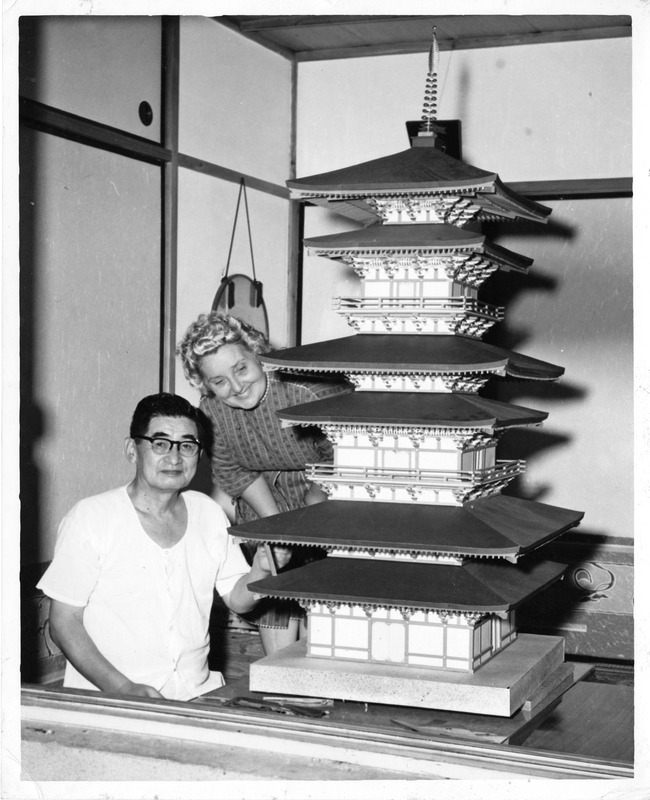
With paper lantern maker, Mr. Nakajima
The picture was taken when the paper pagoda of Yakushi-ji temple was completed by Mr. Tsugito Nakajima. As it only used Japanese Washi paper and glue, building up to this height without any distortion requires a high level of skills and training.
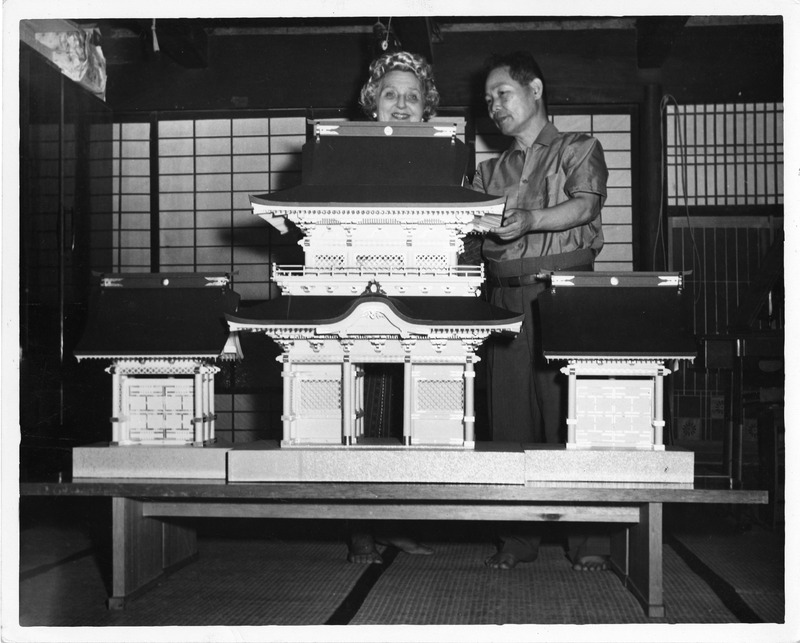
With paper lantern maker, Mr. Yamashita
She met Mr. Tastuji Yamashita, who was chosen as an honorary citizen in the city for his skillful technique, and showed it in front of the emperor.
He showed a paper lantern, Romon gate of Aso shrine.
Mesmerized by Hakata dolls
In 1955, while she was teaching at a school in Okinawa, she saw Hakata dolls for the first time at a small Japanese artifact shop. These dolls are traditional Japanese dolls made of unglazed clay, originally from the city of Fukuoka, which was previously known as Hakata. She was immediately drawn to their realistic appearance and intricate details, and began collecting them. Over time, she collected nearly 3,000 which built the largest private collection of Hakata dolls in the world at that time. She even visited many Hakata doll artists to learn more about them.
Later on, she created a unique flower arrangement style called "Hakata Ryu". This style beautifully combines artificial Hakata dolls with natural flowers in perfect harmony.
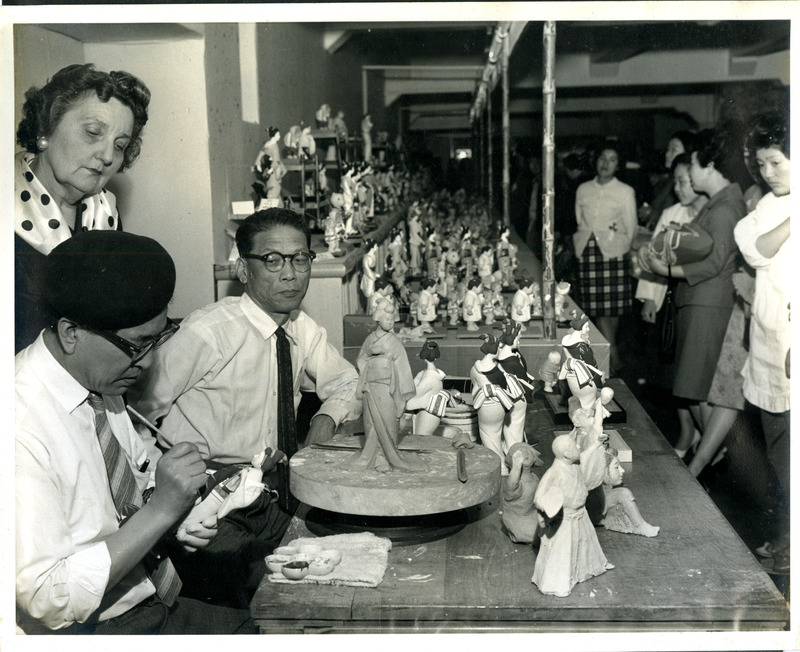
Watching painting of a Hakata Doll
Hakata dolls are all handmade and unglazed clay dolls. It is said it requires years of dedication just to pick up the basics.
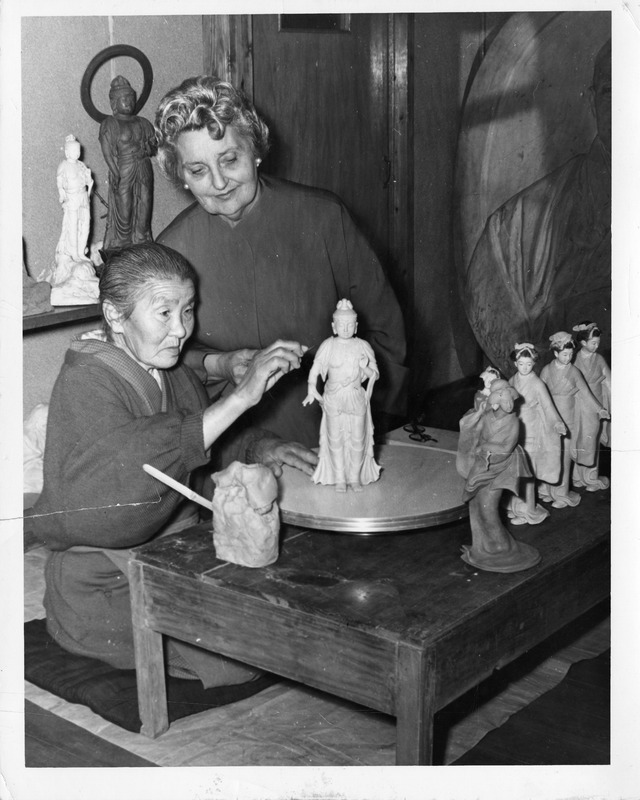
Visiting a doll artist, Mrs. Tami Nakanoko
Mrs. Tami Nakanoko is the granddaughter of Kichibei Nakanoko, the founder of Hakata dolls. She learned from her father, Kichisaburo, from her childhood, and at the age of 21, she started her own carrier. She has lived her entire life devoted to doll making and was selected as a Designated Intangible Cultural Asset of Fukuoka city.
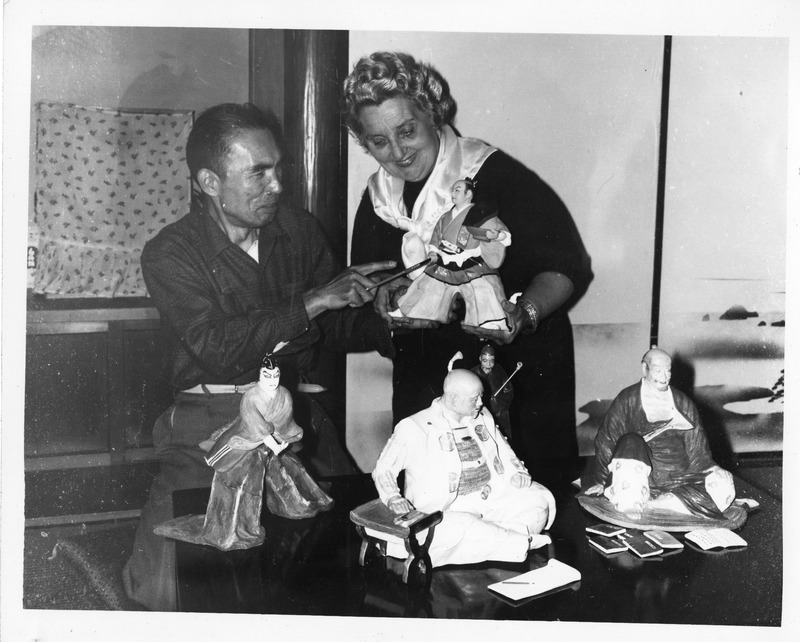
Visiting a doll artist, Mr. Zenjiro Hirano
Mrs. Chandler visited many doll artists during her stay in Japan in order to learn their skillful techniques and dedication to making dolls. She also ordered her original Hakata dolls, such as historical figures not only in Japan but the US.
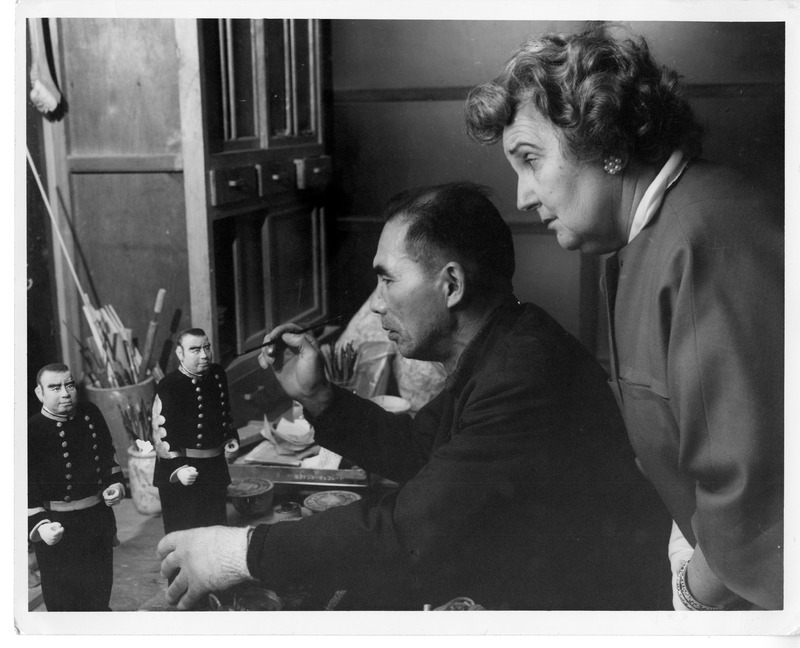
Watching the making process
Each doll is meticulously handcrafted by a single artisan, who oversees every step from carving and sculpting to the final finishing. This results in a diverse range of works that showcase the unique creativity of the maker and exhibit a high level of artistry. Unlike mass-produced items, these carefully crafted dolls possess their own individuality and charm, giving them a sense of life and character.
Encountered an armless artist
In 1965, Mrs. Chandler met Junkyo Oishi for the first time. She was taken by a friend to a solo art exhibition being held at the Takashimaya department store in Japan. There, she met a charming artist who had created beautiful paintings and calligraphy, despite having no arms - she used her mouth to create her art.
Junkyo Oishi was born in Osaka, Japan in 1888. Her parents ran a small sushi restaurant, but she was adopted by the owner of a Geisha house due to her talent for dancing. She became a Geisha, but tragedy struck when her foster father went on a killing spree and cut off both her arms with a Katana sword when she was just 17 years old.
Despite this horrific incident, two years later, Junkyo was inspired by a bird she saw using its beak to feed. She trained herself to use her mouth to write and paint with a brush, and she made a living as an artist. Later in life, she became a nun and opened a small temple to support people with disabilities. She was dedicated to helping others and even founded an art school in Kyoto, Japan.
Mrs. Chandler was so inspired by Junkyo's story that she asked a doll artist to make a Hakata doll modeled after her. Sadly, Junkyo passed away on April 21, 1968, before the dolls were completed. The following year, when the dolls were finished, Mrs. Chandler tried to publish a biography of this unforgettable woman. She donated all the profits from selling the dolls to help disabled people in Japan.
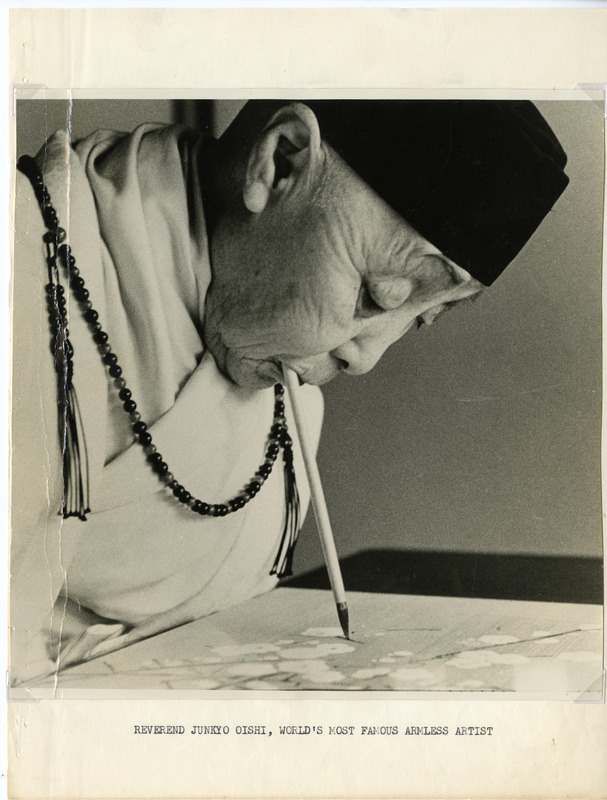
Junkyo Oishi
Junkyo Oishi practiced painting and drawing by using her mouth after she lost both arms. In later her life, she taught her technique and showed her resilience spirit to the people. Especially, she hopes disabilities are able to survive with their talents and positive mind.
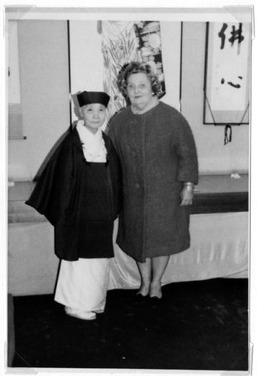
Reverend Junkyo and Mrs. Chandler
Reverend Junkyo and Mrs. Chandler met for the first time at her private exhibition held in Osaka. Mrs. Chandler was moved her charming but strong personality. She took photos of the artist on the day and decided to order to make Hakata dolls modeled by her.
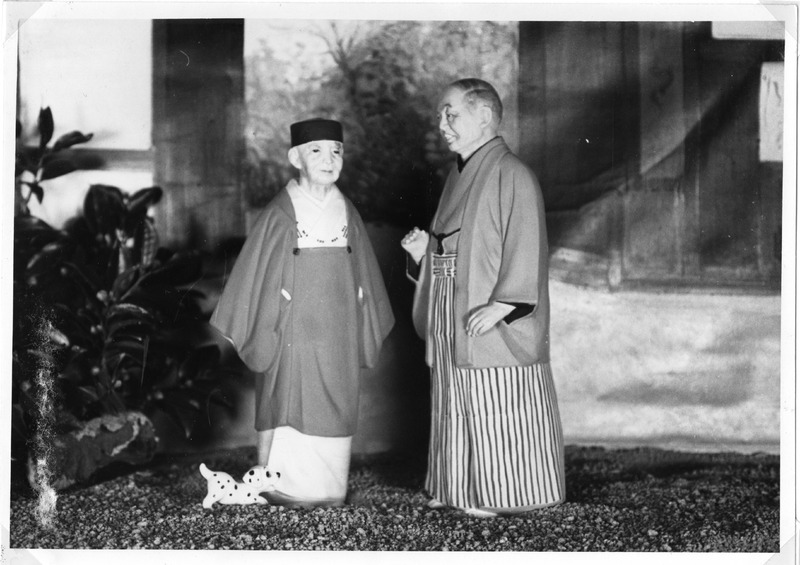
Hakata doll of Junkyo
Junkyo Oishi opened her small temple to the people in need. Mrs. Chundler visited there to meet and interview her.
When the doll was completed, she displayed it in a diorama to tell her story. Hakata dolls of Junkyo Oishi and Kingoro Yanagiya, a Japanese famous comedian and her good friend.
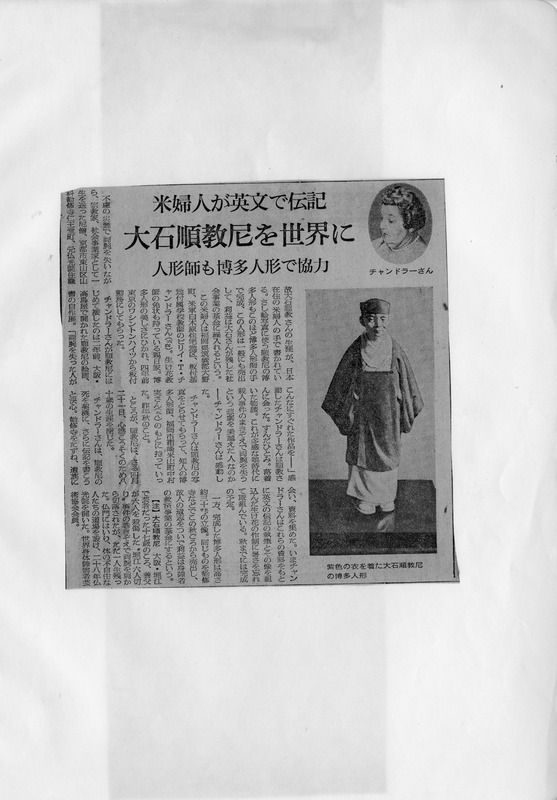
Japanese newspaper article
She ordered the Hakata doll modeled by Junkyo Oishi in order to support disabled people by donating all profits from the sales, and wrote her biography to introduce her life to other countries. She believed that it encourages and inspires people.




